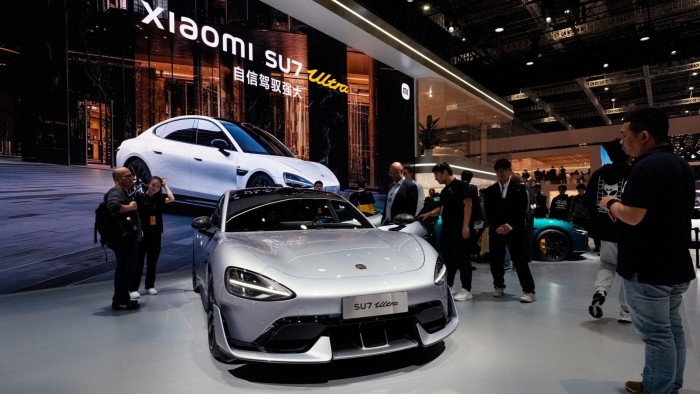Stay informed with free updates
Simply sign up to the Electric vehicles myFT Digest — delivered directly to your inbox.
Carmakers have been forced to tone down their promotion of autonomous driving functions in new models unveiled at this week’s Shanghai automotive show after a safety crackdown by Beijing.
Advertising the self-driving capabilities of electric vehicles has been curbed following a fatal car crash last month — involving a Xiaomi SU7 smart car — that has fuelled debate over the roadworthiness of such technology.
Xiaomi had said its Navigate on Autopilot autonomous driving function had been activated before the accident on a Chinese expressway that killed three young women inside the SU7, its first EV model.
Its founder Lei Jun said he was “heavy-hearted” and acknowledged the public criticism that ensued. Xiaomi has been co-operating with police investigating the cause of the crash.
The accident also ended expectations that Xiaomi, a consumer electronics maker that made a spectacular EV debut a year ago, would follow up by unveiling the YU7, its first electric SUV, at China’s biggest car show.
Xiaomi’s charismatic founder, who attracts huge crowds at corporate events, is skipping the Auto Shanghai show, although the company insisted on Wednesday that the launch date for the YU7 is unchanged, “staying between June and July as anticipated by founder Lei”.
China’s Ministry of Industry and Information Technology, the country’s top automotive regulator, summoned around 60 representatives from major carmakers for discussions last week where it warned them against exaggerating the capabilities of their assisted driving functions.
“Automakers . . . must effectively enhance the safety level of intelligent connected vehicle products,” it said in a statement after the meeting.
The regulatory pressure comes amid intense competition among local players in China to develop such systems, with foreign rivals including Tesla and Mercedes-Benz also scrambling to keep up with the pace of innovation in the world’s largest car market.
China’s tighter regulations have affected the marketing language that carmakers have been using at the Shanghai show, with many emphasising their safety features.
“We need to be super paranoid about . . . what we’ve achieved,” said Giovanni Lanfranchi, chief executive of Zeekr Technology Europe, at a roundtable interview on Tuesday. “Safety is very important.”
Mercedes emphasised drivers were required to stay engaged all the time even though it had developed a “handy and reliable” advanced driver assistance systems (Adas) platform, its China head Oliver Thöne said at a launch event for its new CLA L model in Shanghai.
“Part of the [industry ministry] directive, as we read it, was a call to action to the original equipment manufacturers to clean up the communication,” Mercedes chief executive Ola Källenius told reporters.
“We welcome the government’s tightening of the regulations over the [Adas sector],” said Nio chief executive William Li at a roundtable on Tuesday.
“Safety is number one for Volkswagen,” CEO Oliver Blume said on the eve of Auto Shanghai, while defending inevitable shortcomings in the emerging Adas technology. “You will never have a system with zero defects,” he said.
Huawei, along with a state-backed regulatory body and 11 car manufacturers, also launched a joint initiative. Jin Yuzhi, head of Huawei’s car unit, called on the industry to “eliminate false advertising, clearly define the boundaries . . . of smart driving functions and build user trust”.
Huawei launched an upgraded version of its Adas platform on Tuesday, featuring a collision prevention system and assistance in the case of tyre blowouts or driver incapacity.
Several carmakers and developers of self-driving solutions, including Huawei and Audi’s joint venture with its Chinese partner FAW, have changed their “smart driving” description to more cautious wording, such as “combination assisted driving”, during recent media events.
Last week, BYD requested domestic media outlets and car influencers should avoid using terms such as “God’s Eye” — the original name of its self-driving system — or functions such as “valet parking”, according to people who received the memo.
On Monday, two industry associations published a petition urging carmakers to educate users on the “fundamental difference” between “driver assistance” and “self-driving”.
Under current Chinese regulations, drivers bear full responsibility for traffic accidents involving vehicles equipped with Level 2 driving features, which can assist with simple tasks such as steering, acceleration and braking, but require drivers to remain fully attentive at all times.
For Level 3 vehicles, managing more complex scenarios but still requiring drivers to be ready to take control upon a system prompt, responsibility is shared among drivers, insurers and carmakers.
